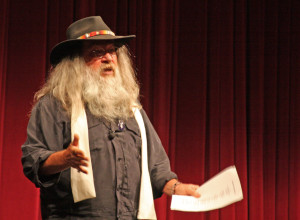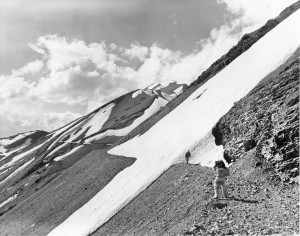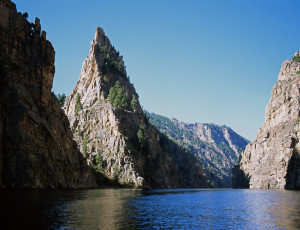by Virginia McConnell Simmons
Roughly 30 years ago, we began to notice the loss of open land, water, other natural resources, traditional ways of life and tranquility in our high mountain valleys. None too soon, we also noticed that something had to be done to prevent the continuing loss of the region’s natural resources, working ranches, and beloved landscapes of Colorado’s high mountain valleys.
The result has been that throughout the state and especially in Central Colorado, we started to adopt innovative, cooperative ways of working together to protect natural resources. One of the most important ways has been the creation of conservation easements and land trusts, a trend that originally was started in Colorado in the 1980s with backing from The Nature Conservancy, and took hold in the 1990s. The movement has grown rapidly in the new century.
Agriculture occupies 80 percent of the state’s land base, and farmers and ranchers with strong personal interests understandably were not enthusiastic about joining the conservation movement at first. So it has helped immensely that the Colorado Cattlemen’s Association got on the bandwagon with its own land trust, and other land trusts also have participants.
We cherish the iconic landscapes and open land that farming and ranching provide, and all the natural resources on or off agricultural land. The natural resources are not confined to these lands, however, and they are diverse.
The resources include wildlife habitats; clean air and flowing water; riparian zones, wetlands, fens and hot springs; rare plants and plant communities; fish; birds (think Gunnison Sage Grouse); and even bats (Mexican Free-tailed). These are reasons why many of us choose to live here.
One of the most successful ways of doing something about it has been the creation of conservation easements and land trusts. Briefly, the trusts are private, nonprofit organizations that acquire and administer easements for conservation, although other types of trusts may be involved with historic preservation.
Conservation easements enable property owners to retain ownership of property while meeting specific conservation goals or a variety of them. The decision of a property owner to create an easement is voluntary, and he, she, or they can sell or transfer it, but the specified portion containing the easement exists in perpetuity. A land trust holds the easement and periodically visits the easement to verify that appropriate uses and conservation goals are being practiced. In Colorado at present, there are 35 land trusts holding conservation easements.
The path between a proposal to establish a conservation easement and the joyful celebration of the marriage between property owner and land trust is not easy. It requires thought, effort and time, so the courtship may take years, involving evaluation of natural values; appraisals; planning, perhaps among extended families or with cooperating land managers and contiguous governmental lands; funding, which may come from multiple sources, such as foundations, individuals, or public programs like GOCO; accounting; and certification, which is required by the State of Colorado.
Some land trusts work both in broad geographical areas, in and beyond Central Colorado, while others are active in narrower grassroots areas. Among the larger ones are organizations like The Nature Conservancy, Colorado Cattlemen’s Agricultural Land Trust, Colorado Open Lands, American Farmland Trust, Ducks Unlimited, Palmer Land Trust and others.
Complex partnerships also occur, like the easements along 15 miles of the Tomichi Creek corridor, where agriculture and natural resources both were important, or in the thousands of acres on two parcels comprising Trinchera-Blanca easements in the eastern San Luis Valley, with various objectives, but mainly wildlife. Easements along the Lake Fork of the Gunnison have a mix of interests, too – grassland, forest, and of course, fish. But even small easements can be complex, for example, the Orient Land Trust owns the property, but The Nature Conservancy holds the easement and the BLM provides public access to the Orient Mine.
Several midsize land trusts in Central Colorado include the Land Trust of the Upper Arkansas, Rio Grande Headwaters Land Trust, Gunnison Ranchlands Conservation Foundation, and San Isabel Land Protection Trust, while some smaller projects are not locally focused, such as the Orient, Crestone/Baca, and Crested Butte. Such trusts with local offices operate with small staffs that are supported by volunteer boards of directors and area residents who support the program.
Because donors of easements often wish to protect their privacy, the public may not realize how many easements exist or the quantity of land that is being protected collectively, except when the aforementioned weddings take place and publicity appears.
Statewide, here are a few statistics attesting to the considerable presence of easements: 10 percent of the state’s land mass is now held in conservation easements. Topping the region for acreage, the San Luis Valley’s easements occupy 20 percent, totaling 350,000 acres, and there are 14 land trusts. Rio Grande Headwaters Land Trust (RiGHT) alone holds 32 easements, with an emphasis in agricultural land, though not solely, and its largest is 3,200 acres.
Here is some other data from Central Colorado to give an idea of activity – not to imply that any single trust or easement is more important than another: The Nature Conservancy’s holdings, with emphasis on natural values and habitat, has 9 easements in the San Luis Valley totaling 11,158 acres, 11 easements in Gunnison County totaling 6,590 acres, and 26 easments in Park County totaling 6,590 acres.
Are there disadvantages for placing a conservation easement on a piece of land? Well, an owner or heirs cannot make a killing by selling the land with the easement to a developer for ranchettes, shopping malls or the energy industry. A financial advantage, on the other hand, is that tax assessments will not include future potential for development on the easement’s land.
Meanwhile, he or she will sleep better knowing that something significant has been done for planet Earth.
Virginia McConnell Simmons moved to Colorado in 1954, thanked her lucky stars, and has been writing about this region ever since.



